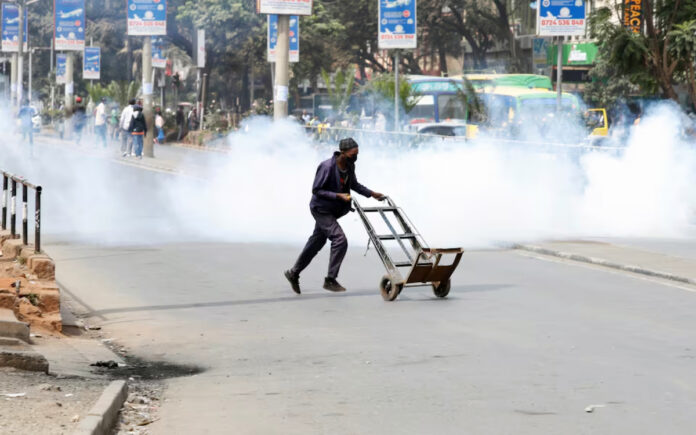Nairobi: Riot police used tear gas to disperse protesters in Kenya’s capital Nairobi on Tuesday, as demonstrations erupted in multiple towns following a call for more protests by young activists after a week of deadly clashes.
Reuters journalists reported clouds of tear gas on a main road through central Nairobi before midday, where riot police in helmets had been stationed since early morning.
Outside the capital, Kenyan television stations broadcast scenes of hundreds of protesters marching peacefully, carrying palm fronds in Mombasa on the Indian Ocean coast, and dozens in Kisumu on Lake Victoria. In the southwestern town of Migori, protesters set tires on fire.
The protest movement, which lacks official leaders and primarily organizes via social media, has rejected President William Ruto’s appeals for dialogue, despite his abandonment of proposed tax increases that triggered the demonstrations.
Since June 18, dozens of Kenyans have died in protests and clashes with police, with most of the fatalities occurring last Tuesday when officers shot at protesters attempting to storm parliament to prevent a vote on the tax hikes.
Also Read | Bird Flu Forces McDonald’s Australia to Reduce Breakfast Service
Demanding Ruto’s Resignation
Infuriated by the deaths—at least 39 according to the government-funded Kenya National Commission on Human Rights (KNHCR)—many are now calling for Ruto to step down. “We are determined to push for the president’s resignation,” said Ojango Omondi, an activist in Nairobi. “We hope for a peaceful protest and minimal casualties, if any.”
Authorities have appealed for calm. “It’s a beautiful day to choose patriotism. A beautiful day to choose peace, order and the sanctity of our nationhood,” State House communications director Gerald Bitok wrote on X, adding in Swahili: “Violence is not patriotism.”
Also Read | UK General Election 2024: Immigration Takes Center Stage as the Key Issue
Downtown Nairobi was busier on Tuesday morning than in recent days, with shops that had been closed during the protests reopening. Many residents believed the worst of the unrest had passed. “I think it’s not going to be maandamano (protest) because maybe people are afraid, because some people have been shot,” said Kennedy Otwal, walking through downtown.
The protests, which began as an online outpouring of anger over nearly $2.7 billion in proposed tax hikes, have evolved into a nationwide movement against corruption and misgovernance.
Also Read | Intense Bombardment Forces Thousands to Flee Southern Gaza
Caught Between Demands
Facing the most serious crisis of his nearly two-year presidency, Ruto has been caught between the demands of international lenders like the International Monetary Fund, which require deficit reductions, and a population struggling with a soaring cost of living.
Ruto has directed the treasury to find ways to cut spending to address the budget gap caused by the withdrawal of the finance bill, and has also indicated that more borrowing will be necessary.
Veteran anti-corruption activist John Githongo told Reuters that while Ruto had addressed the nation and media, “there isn’t an indication that he wants to take action” on protesters’ demands, including firing corrupt officials. “There hasn’t been any indication by the government that they are going to take the calls to deal with corruption seriously,” he said.
The protests were largely peaceful until last Tuesday, when some protesters briefly stormed parliament and set part of it ablaze, prompting police to open fire. Ruto has defended the police’s actions, blaming the violence on “criminals” who hijacked the demonstrations.



